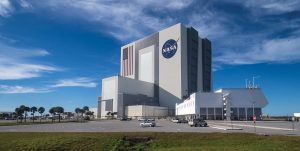To Infinity and Beyond
 Looking up to contemplate the heavens and all the wonders of the starry skies unites humanity across millennia. For thousands of years, marveling at the infinite mysteries beyond our pale blue dot has challenged the greatest minds of every generation, rewarded awestruck onlookers with dazzling celestial displays and inspired billions of wishes made upon a skyful of stars—and, in modern times, probably even a couple satellites, too.
Looking up to contemplate the heavens and all the wonders of the starry skies unites humanity across millennia. For thousands of years, marveling at the infinite mysteries beyond our pale blue dot has challenged the greatest minds of every generation, rewarded awestruck onlookers with dazzling celestial displays and inspired billions of wishes made upon a skyful of stars—and, in modern times, probably even a couple satellites, too.
It is a privilege of good timing to be born in an age when we walk among those who’ve walked on the moon, have brilliantly detailed images of other worlds at our fingertips and know more than we ever have about our galactic neighbors, even when every discovery inspires a treasure trove of new questions to explore.
And just as Central Florida has hosted so much of the aerospace industry’s history-making moments of the past, it is right at the heart of today’s innovations and initiatives that are shaping its more-promising-than-ever future, both in terms of locale and the talent it cultivates.
“UCF (The University of Central Florida) has more graduates that we place into aerospace fields than any other university in the United States,” notes Dr. Phil Metzger, a planetary scientist with UCF’s Florida Space Institute. “The more that the space industry grows, the more aerospace grows, the more it’s important for UCF to be putting out all these workers in the field, so we’re a real center for developing expertise in the space industry.”
Metzger continues: “The I-4 Corridor, from Daytona Beach to Tampa, right through Orlando and Central Florida, is this corridor of high-technology development that the state of Florida has been supporting and helping to build up over the years. Along this corridor, we have a wide range of technologies being developed: optics, lasers, medical technologies, robots, manufacturing technologies. All of these technologies are part of the ecosystem of industry that supports aerospace. … That technological development has, in part, been energized by the space program.”
In recent years, the aerospace industry has seen a resurgence of public interest. For those who have made a career of making the universe’s endless expanses accessible to their fellow Earthlings, that reinvigorated attention has not gone unnoticed.
“I don’t think people lose interest in space, but I would say there’s been a transformation in the current interest that you see today,” says Burt Summerfield, associate director, management, of NASA’s John F. Kennedy Space Center (KSC). “Any time you have activity, people are interested in seeing what’s going on.”
Summerfield began his career at Kennedy in 1982, a decade after Apollo 17 marked America’s last manned lunar trip. While scientific missions have continued well beyond the 30-year shuttle program that shuttered in 2011, Summerfield posits that the general public’s awareness of NASA projects hit a lull without “the excitement and interest of the shuttle program.”
Among the key drivers of pursuing space exploration with renewed vigor is its undeniable economic potential, as well as a critically lowered financial barrier to entry.
“I think one of the biggest differences is that we now are thinking about economic activities in space that utilize space resources—and that was not possible more than 10 or 15 years ago,” says Metzger. “The cost of getting into space has come way down. The companies that are creating commercial abilities to get into space have revolutionized space access.”
Perhaps fitting for a sector that put human beings on the moon with less-advanced equipment than a contemporary graphing calculator, modern technological advancements have encouraged seemingly limitless potential for aerospace endeavors that Summerfield says “really explore boundaries and advanced science, and involve more people than ever before.”
With the past few years yielding everything from New Horizon’s glimpses into Pluto’s icy expanse to the Event Horizon Telescope’s history-making black hole image, to the untold, high-res riches the James Webb Space Telescope is transmitting home with its infrared eye and the moon-orbiting Artemis mission, the current capabilities of technology certainly deserve some credit for drawing our collective attention upward.
“Robotics and artificial intelligence are dramatically improving,” Metzger points out. “That is giving us the ability to do more things robotically in space, including commercial activities like mining on the moon, mining asteroids and creating rocket fuel in space using water from the moon. That should lead into a whole other range of viable commercial activities, like the groups looking into doing tourism on the moon.”
“We’ve already had 39 launches this year, and are heading toward over 60 launches by the end of the calendar year—that’s a lot of opportunities for people that otherwise wouldn’t have seen one launch every couple of months to see it and feel it, more so than any other time,” Summerfield explains. “Technology really allows us to do these things that were unheard of back during Apollo. Apollo was a focused national-interest program that really set the bar for science and exploration and what we as a nation could accomplish. What you’re seeing now is an explosion of opportunities, not just from a government perspective but also a private perspective.”
Space Florida’s VP Government & External Relations Dale Ketcham observes that modern solutions have begun addressing some decades-long issues, due in part to private operations bursting onto the scene.
“We could have done something like reusing your launch vehicles a long time ago, but we didn’t have the software,” he says. “It took [SpaceX] to finally realize that throwing away your rocket every time you use it is kind of stupid. … But it required a definitive level of performance from your software to bring the vehicles back safely and repeatedly, and a commitment to building vehicles and engines that could be reused without a huge amount of expense.”
Both SpaceX and Blue Origin declined to comment, but veterans of aerospace spoke highly of commercial entities’ unignorable industry-wide impact.
“I’d say the biggest single change in recent years is the growth of the commercial sector,” Ketcham continues. “The private sector has become ever-more involved and is paying an ever-larger share of the space program. Anything that the private sector can do frees the government up to focus on its core mission—exploration and national security—while bringing innovation and competition and a heck of a lot of their own money.”
“It helps generate interest within the nation and outside—that’s a good thing, there’s nothing wrong with that,” Summerfield adds. “They have certainly brought an infusion of resources that I think has made an impact, when you look at things moving forward and operational activities. … It’s an added emphasis and awareness that I think people see and enjoy. They enjoy seeing the missions go up and the launches happen.”
Summerfield notes that it’s not just the likes of Jeff Bezos’ and Elon Musk’s entrance into aerospace that has jump-started the industry’s commercial strength, and that the proliferation of smaller start-ups that are “out there looking to tackle something that’s very difficult and provide access that people otherwise wouldn’t have” makes for some especially exciting times.
“It’s a super opportunity, and one that we cherish from a NASA perspective because we’re looking to promote more commercial space activity,” he continues. “We’re benefactors of their work and they’re benefactors of ours because we share information freely. I think we’ve made a huge impact on all the programs that are out there now because we’re able to provide insights into our experiences and what we’ve learned, what works, what doesn’t work to help them succeed. They have exceptionally talented people working with them who are able to share back and forth, which has been good for all of us.”
Fostering an environment of shared information doesn’t stop at country borders, though. As Summerfield explains, “We have a lot of partners internationally that work with us as part of our missions of exploration. We rely on those partners, they rely on us: It’s a very important relationship we have with our international partners, which really gets our missions accomplished. Space exploration is a very large endeavor, and it’s not just limited to the United States’ efforts. It’s a combination of international efforts.”
Space exploration, after all, benefits—and affects—the entire global community.
“Once you’re no longer confined to the surface of a globe, space is endless—and there’s something inherently symbolic about that, for how the possibilities for what we can create are endless,” says Metzger. “There’s also geopolitical concern: We don’t want space to be weaponized, we don’t want countries to fight over space.”
It is, of course, not all starry-eyed wonder: There are obvious political ramifications and implications to consider within the context of an industrialized aerospace.
“We project to the world that we are capable in space and, therefore, it would discourage other countries from starting an arms race. … One way we do that is by having a strong civilian program,” Metzger continues. “I think that’s an underappreciated aspect of the space program: It’s really the reason why NASA was created. We didn’t go to the moon to collect rocks and do science—the science was almost an afterthought! The reason was to try and project strength so our allies would be confident in us and the countries that are more adversarial would be deterred from starting a fight.”
And Ketcham adds that there will be some somber, sobering milestones along the way, a tragic inevitability that comes with doggedly pushing at the boundaries of what once was impossible.
“I think, because we are expanding human activity into space, it’s going to be a lot like the opening of the New World or the American West: It’s going to bring in a host of people, and it’s going to be dangerous—we’re going to lose people,” he warns. “Getting into space remains extremely dangerous, and that’s not going to change. But the benefit, the excitement, means that people are going to do it, because that’s what humans do.”
The risks of going where no human being has gone before are well-documented and accepted as the inherent consequence of bravely blazing new trails into uncharted extraterrestrial terrain. And just as many will always be content to keep their feet planted on terra firma, there are similarly grounded and immediately tangible benefits to the aerospace industry calling Central Florida home: a bolstered economy.
“We have been, I think, a significant economic force in the state for some time,” Summerfield says. “Just this past year, for about every dollar that NASA KSC spent, you saw something like $1.82 return to the state. So it’s a fairly substantial return on the investment. And you’re seeing continued high-tech job growth. These are well-paying, professional jobs, and all that tends to spill over into every sector of the economy.”
“There are a lot of different jobs with different industries with different commercial-sector applications,” adds Ketcham. “That’s a good thing because, in case one program gets canceled or a company goes bankrupt, you’re diversifying your industrial base. Plus, as the price to orbit comes down, which is what’s happening, more and more ideas, businesses, research and exploration will be able to afford going into space, and that’s opening up an entirely new arena of human enterprise.”
That human impact does reach optimistically toward the future, particularly by capturing imaginations of all ages with not only a professional future but also by making space more accessible than ever.
“Space encourages young people to excel in school and to work hard in order to be a part of it,” says Metzger. “I see firsthand all the time—not only with college students but I work with younger students through things like robotics clubs—that space is truly inspiring and energizing for young people. … I think it’s important for companies to continue creating youth opportunities. Internships are really pivotal to a student’s academic and professional development.”
“For the public, the future of space manufacturing and tourism is going to come faster than anticipated,” Ketcham adds. “It’s all going to help us understand the majesty of the universe in which we live, and the mysteries and the wonders that are out there to be understood.”
Even returning to our closest celestial neighbor has the potential to unlock some of those long-held secrets of the universe. “The moon is going to help us solve some of the greatest challenges in science, including helping us to understand the conditions for life in the cosmos … by unraveling the history of asteroid and comet impacts on the moon,” Metzger says. “We can’t get that information from the Earth because the climate and weather destroy the evidence. But on the moon, an airless body without plate tectonics, without weather, that record has been preserved.”
And infusing exploration and educational opportunities with inclusion assures the next generation of star gazers and scientists that, no matter where you came from, you can always be a part of where space exploration is going.
“Our mission is a lot more diverse and we’re more inclusive,” Summerfield says. “With Artemis, as we look to go back to the moon, our goal is to put the first woman and the first person of color on the moon.”









